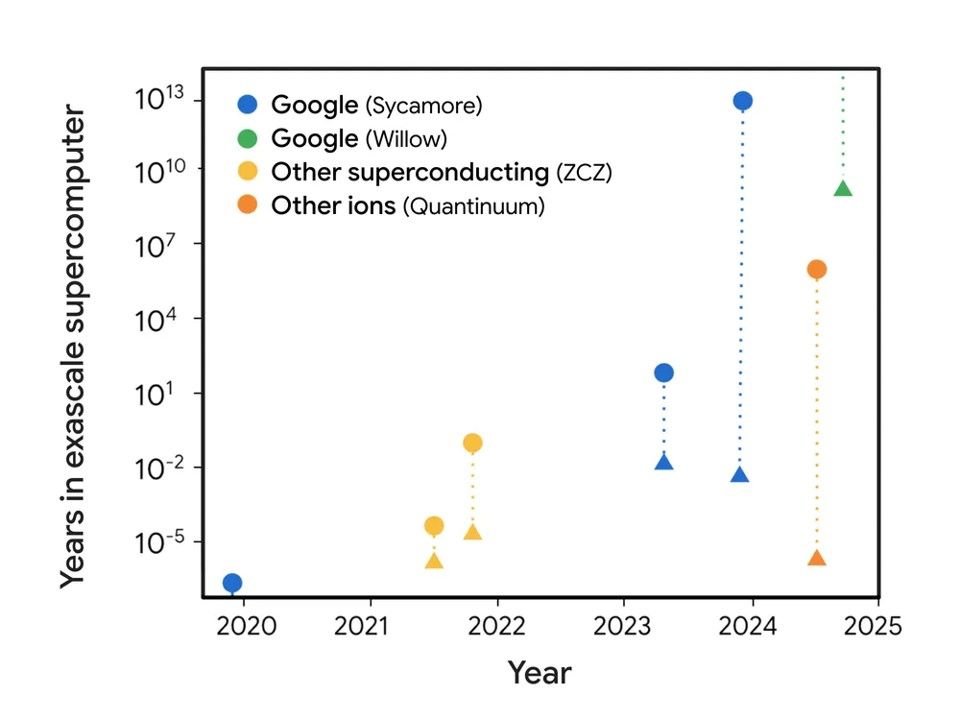Google’s Quantum Chip Willow Outpaces World’s Fastest Supercomputer
Google has announced a groundbreaking achievement in quantum computing with its latest chip, Willow. This state-of-the-art quantum chip – Google Willow – has tackled a long-standing problem in the field, marking two significant milestones that could redefine the future of computation. According to Hartmut Neven, founder and lead of Google Quantum AI, Willow has “exponentially” reduced error rates as more qubits are added—a challenge that has persisted for nearly three decades.
Quantum computers offer many promising applications dependent on greatly improved performance. Read how we’ve combined quantum error correction w/ our latest superconducting processor, Willow, exponentially reducing error rates w/ increasing qubit scale →https://t.co/flyuINreWy pic.twitter.com/AFcv8bPX5c
— Google AI (@GoogleAI) December 9, 2024
The Problem with Qubits
Qubits, the computational units of quantum computers, represent an advancement over classical computer bits. While classical bits process information as 0s or 1s, qubits can exist in a state of superposition, being both 0 and 1 simultaneously. This enables quantum computers to perform tasks that classical computers cannot.
However, adding more qubits typically increases error rates, diminishing the quantum system’s reliability. Errors in quantum systems occur because qubits rapidly interact with their environment, losing the information needed to complete computations. Addressing this issue has been one of the greatest challenges in quantum computing, Neven explained.
Willow’s Breakthrough Achievements
Google Quantum AI’s Willow chip has achieved what experts call “below threshold” error rates, meaning errors decrease as the number of qubits increases. This historic accomplishment was demonstrated by testing increasingly larger grids of encoded qubits, with the error rate halving each time.
In another feat, Willow performed a computation in under five minutes that would take Frontier, the world’s fastest supercomputer, an estimated 10 septillion years to solve. This assessment, based on conservative benchmarks, underscores Willow’s revolutionary capabilities.
The Industry Standard: Random Circuit Sampling
To measure Willow’s performance, Google employed random circuit sampling (RCS), an industry-standard benchmark for quantum computing. According to Neven, this is the “classically hardest benchmark” achievable on a quantum computer today. The results published in Nature on Monday solidify Willow’s status as a technological game-changer.
Real-World Applications of Quantum Computing
Willow’s success illustrates the potential to create large-scale, practical quantum computers. Quantum systems are already playing a role in cutting-edge fields such as drug discovery and the development of efficient batteries for electric vehicles.
Neven emphasized that Willow’s achievements pave the way for the realization of “useful, large-scale quantum computers,” promising to transform industries from healthcare to energy.
A Future Defined by Quantum Innovation
As the race to harness quantum computing accelerates, Google’s Willow chip represents a monumental step forward. By overcoming the persistent issue of error rates while showcasing unmatched computational power, Willow reaffirms the transformative potential of quantum technology in solving problems far beyond the scope of classical systems.
See Also:
Pushpa 2 Creates Box Office History
Ousted Syrian President Assad Granted Asylum in Russia
Bank Manager Assaulted Over Fixed Deposit Tax Deduction
Delhi Influencer’s Bizarre Green Chilli Lip Plumping Hack
——————————————————————————-
It would mean the world to us if you follow us on Twitter, Instagram and Facebook. At Newscazt, we strive to bring you the latest news and stories from India, World, Business, Sports, Entertainment and more. Our team of experienced journalists and writers are committed to delivering accurate and unbiased news and analysis.




